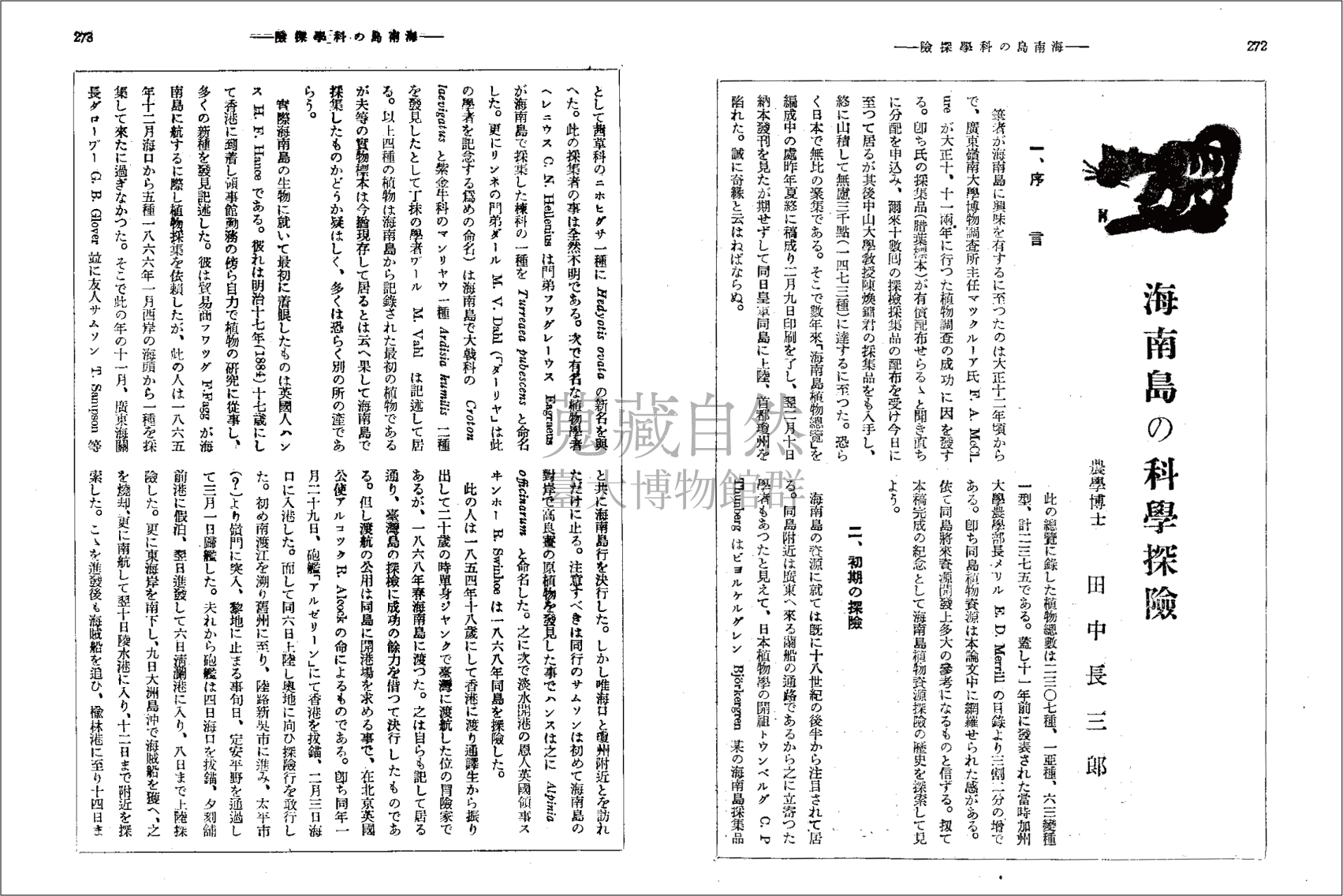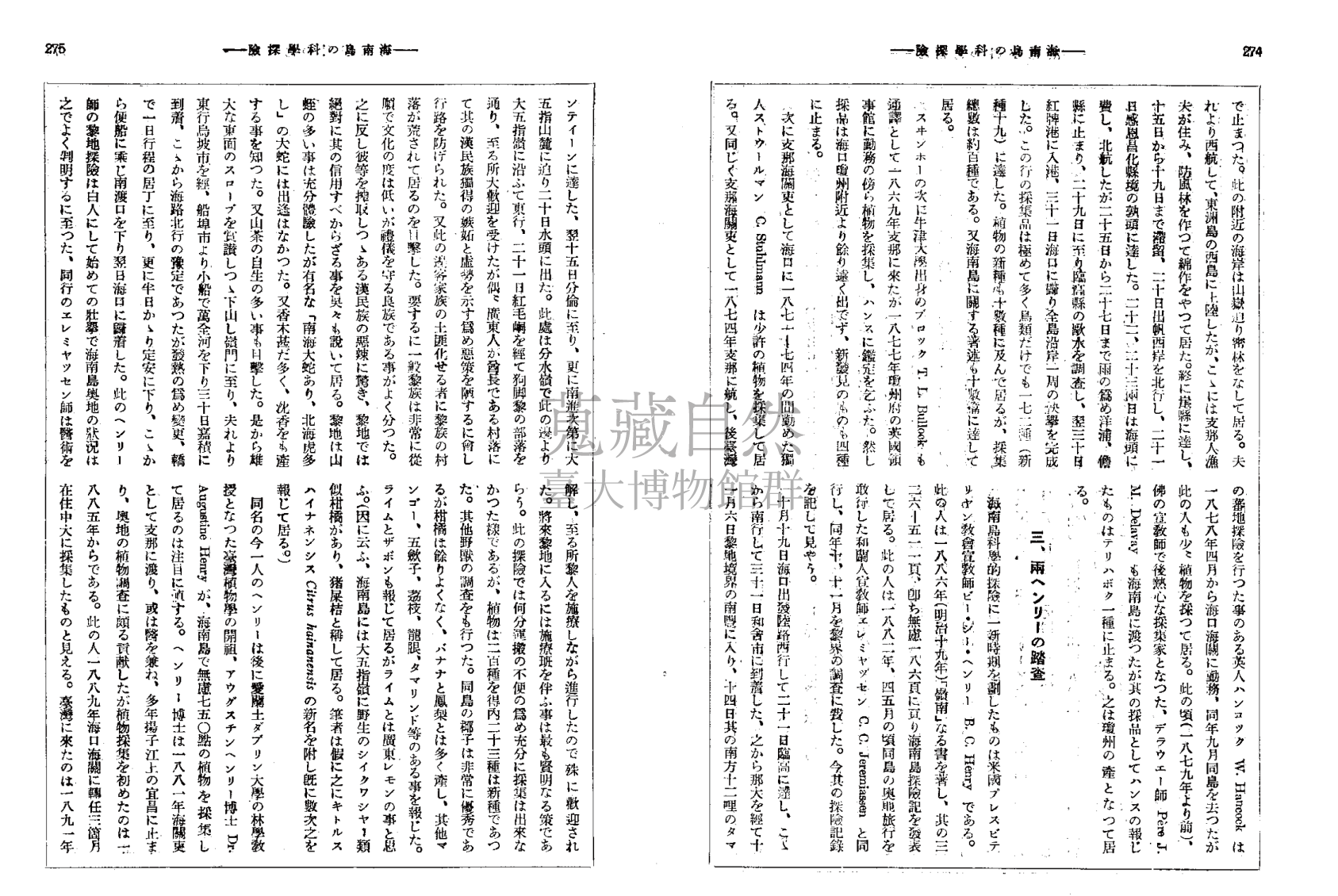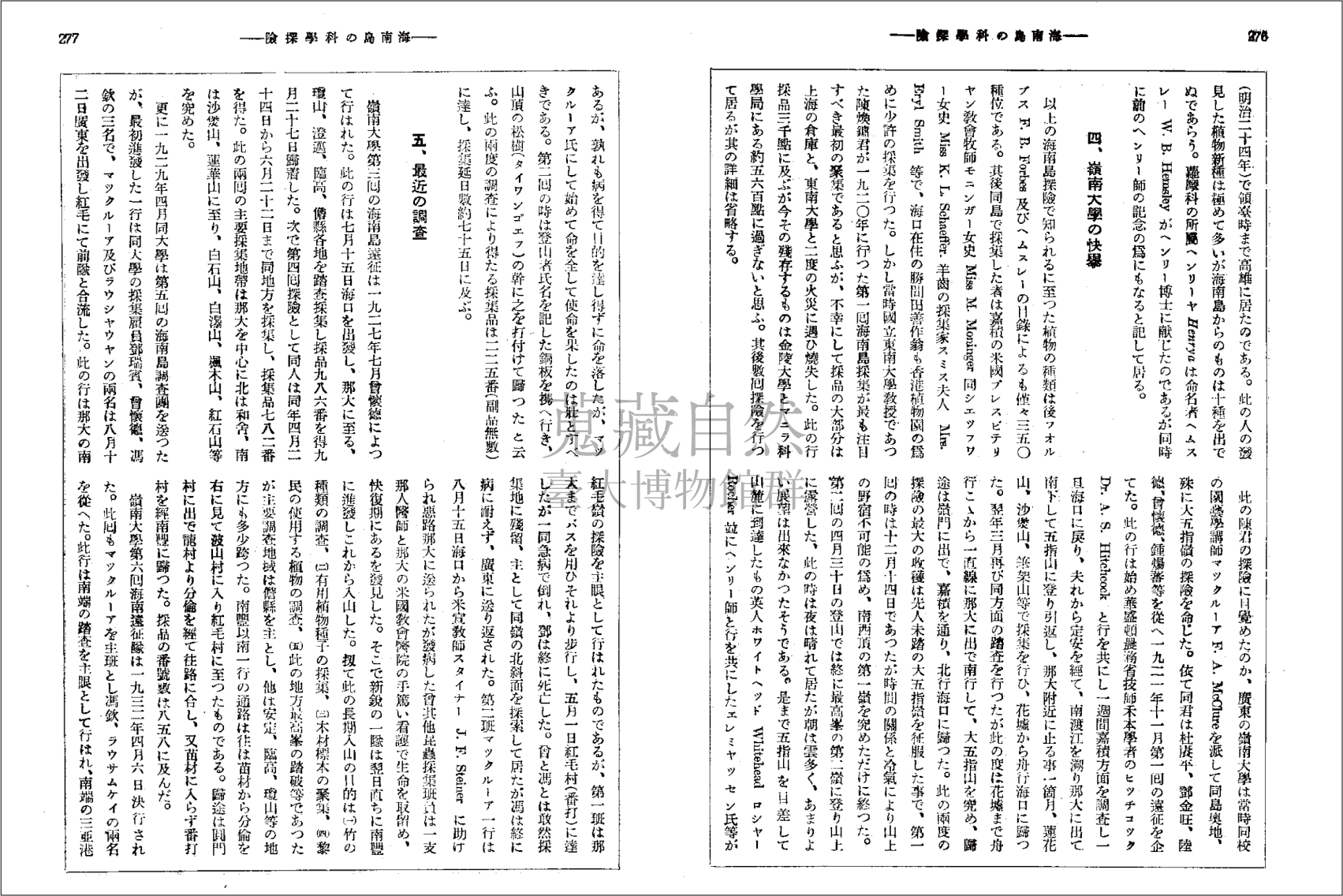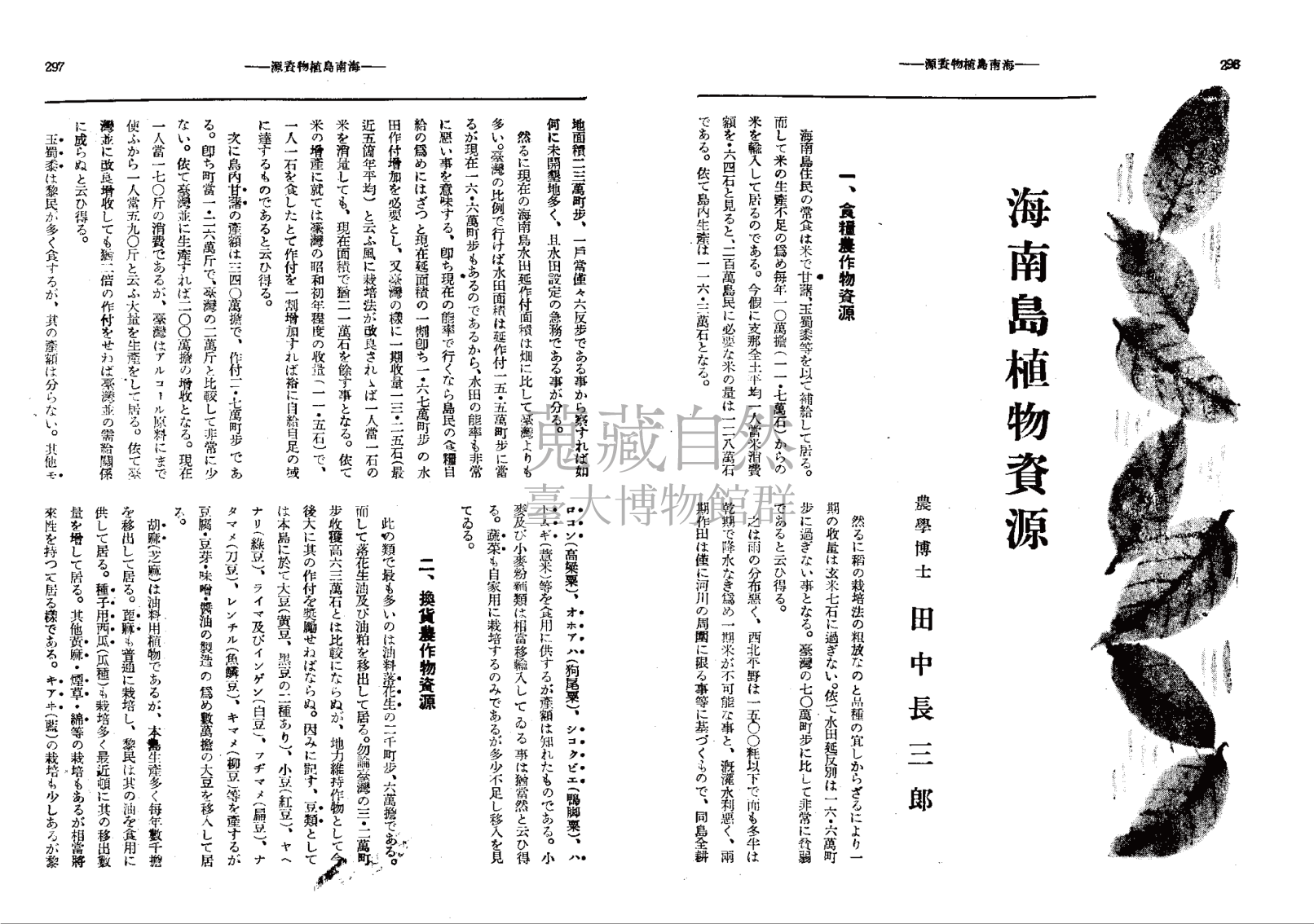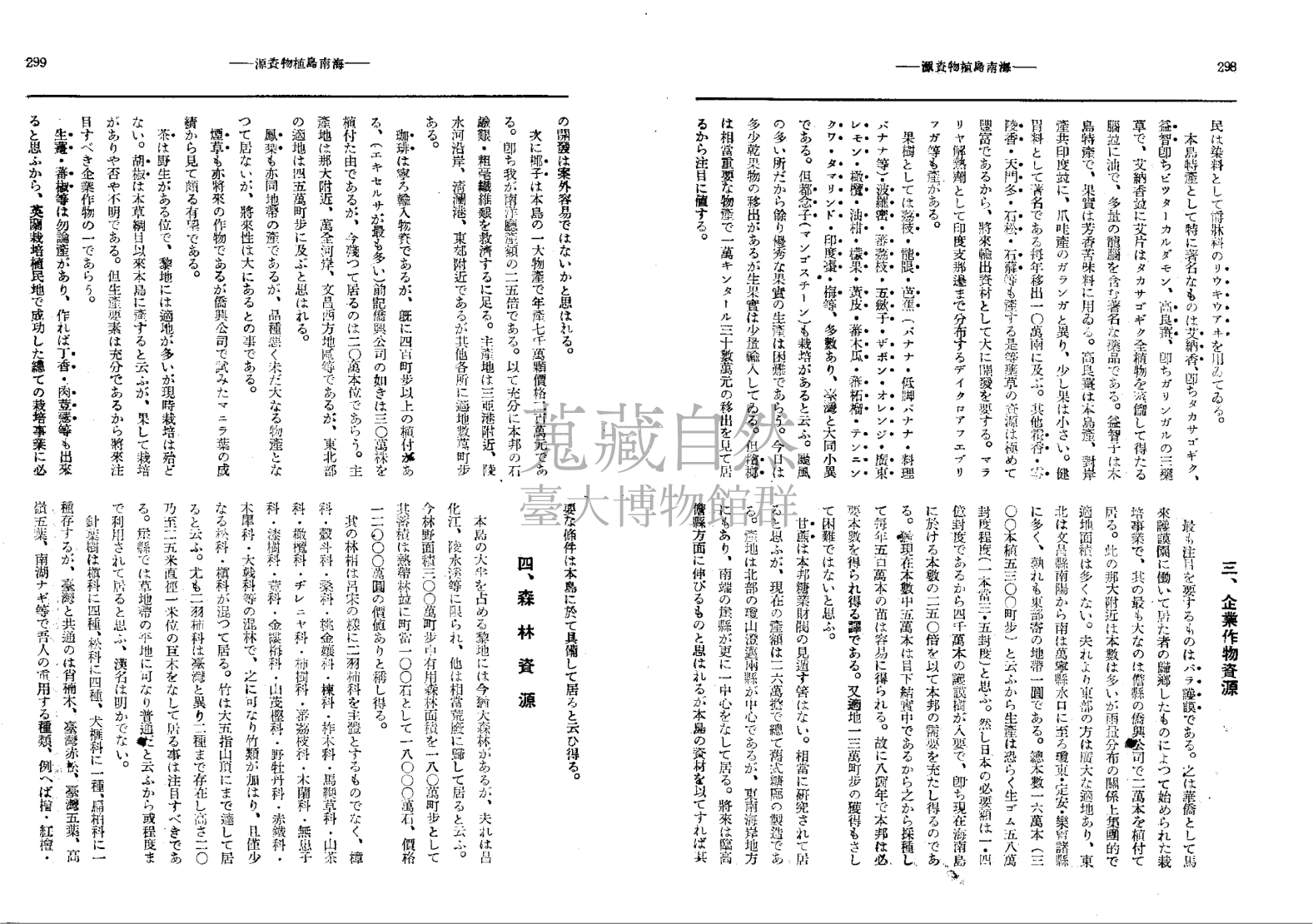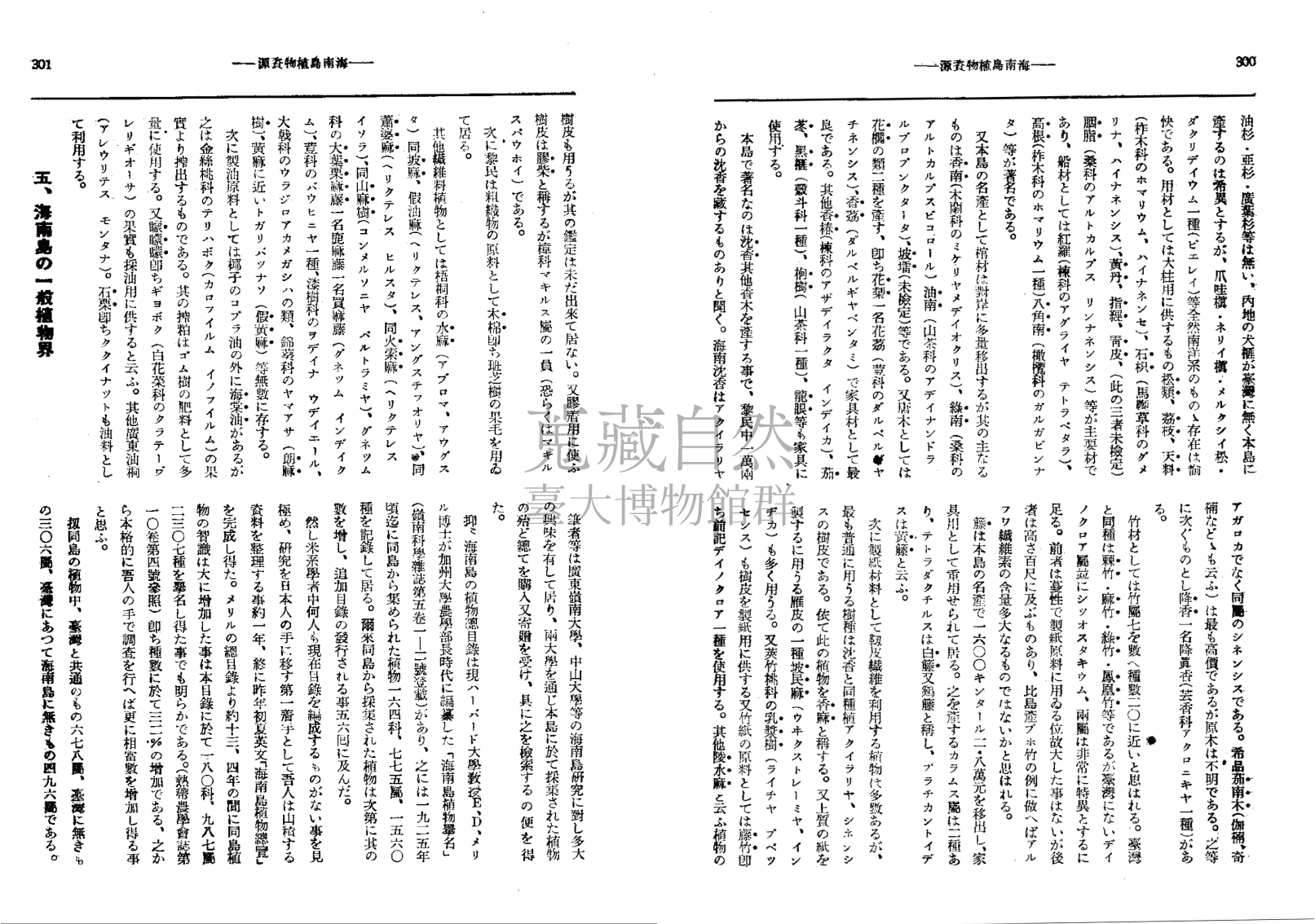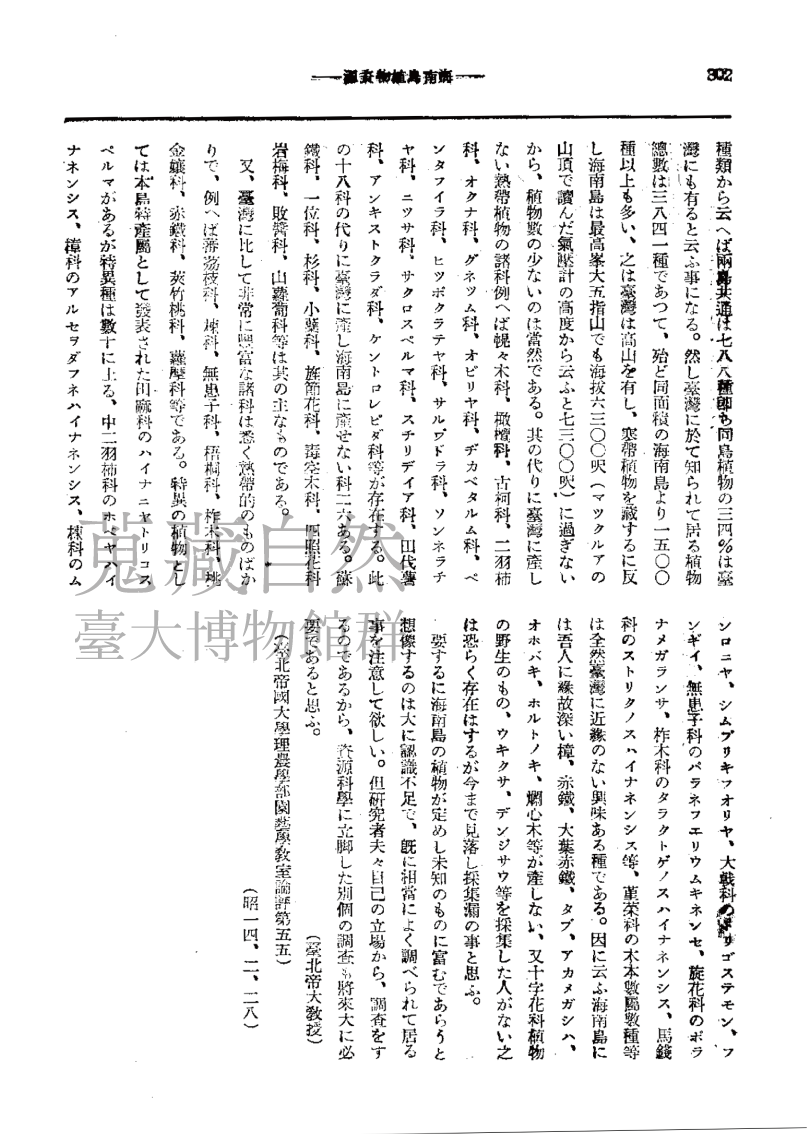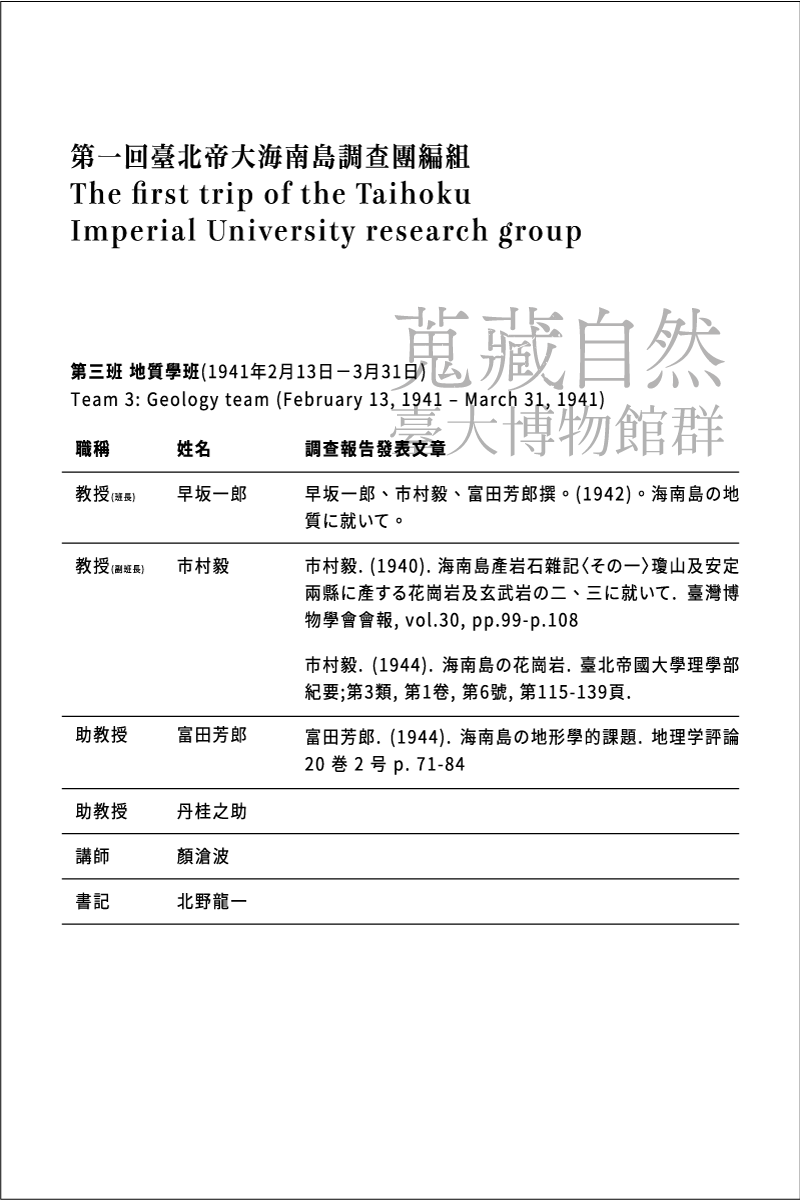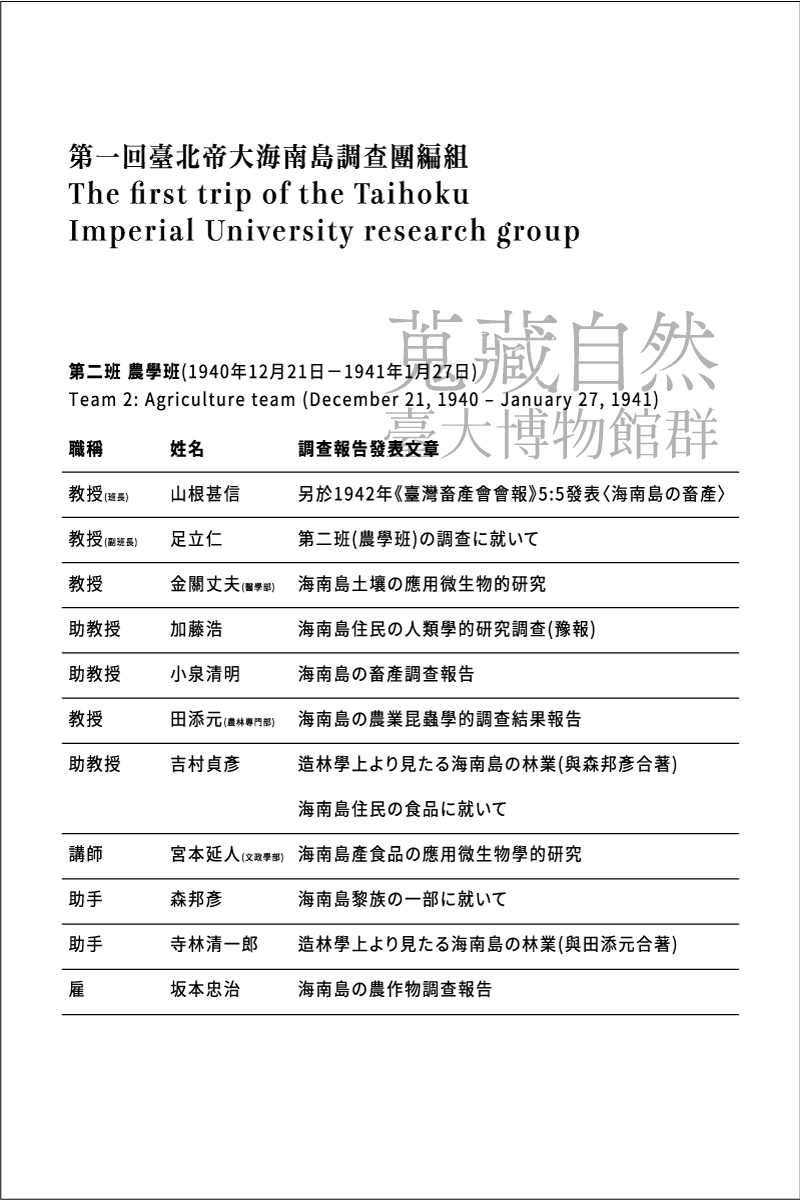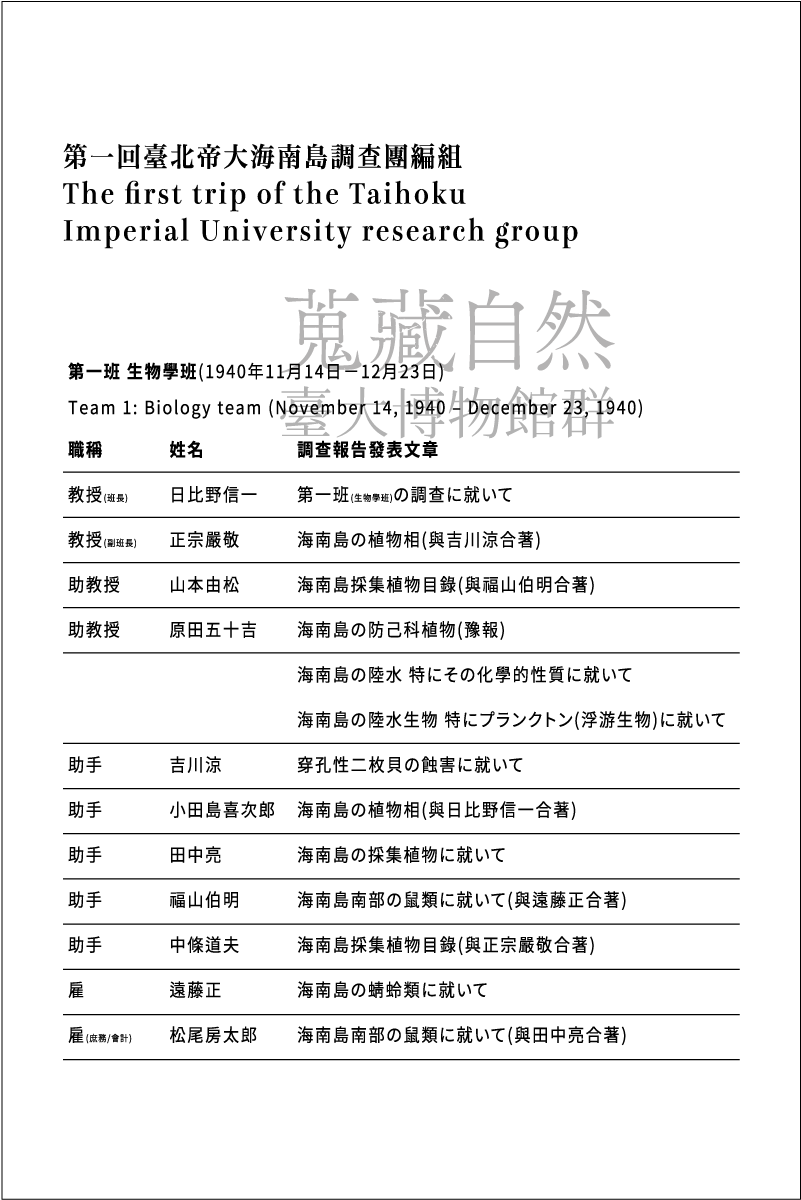其他成果 Others
海南島的自然史調查
Natural history survey in Hainan
日本在20世紀初期有多位學者前往海南島進行資源調查,而臺北帝大則自1938年起,由理農學部的田中長三郎教授從購自中山大學陳煥鏞教授的海南島標本,與小田島喜次郎共同整理發表《海南島植物總覽》。其後理農學部的平坂恭介和川口四郎也在1940年7月順道進行動物學的先期探勘。
臺北帝大在1940–1942年組成全校性的調查團前往海南島,主要以理農學科為骨幹。海南島調查團共進行兩次,第一回的調查團分為三班:生物學班、農學班,以及地質學班,三班分別以不同時間及路線進行調查。
第二回的調查團大部份和自然史基礎研究較無關係,只有昆蟲學方面小泉清明、柴田喜久雄進行農業昆蟲資料的補齊,以及田中亮延續海南島鼠類的調查。此次的調查規模較小,且沒有進入內陸調查,故從自然史研究的角度來看,其重要性不若第一回調查來得高。
除了上述第二回的海南島調查團,臺北帝大也有多位學者在1942年間接受海軍特務部委託進行「黎族及其環境調查」,後續有5份研究報告發表,其中和自然史相關的有兩篇,一個是山本由松發表的《海南島植物誌料I》,包含總數1700百份標本的整理,以及繪製海南島西南部份的植被圖。另一篇則是原田五十吉發表的《海南島に於ける淡水魚調查報告書》,在島上9條主要水系,以炸魚的方式進行魚類調查。
Since the early 20th century, numerous Japanese scholars have visited Hainan for natural resource surveys. From 1938 on, Taihoku Imperial University professor Tanaka Tyozaburo collaborating with Odashima Kijiro published “A Census of Hainan Plants.” Subsequently, professors Hirasaka Kyosuke and Kawaguti Siro from Taihoku Imperial University conducted a preliminary zoological exploration in July, 1940.
The Taihoku Imperial University formed a university-wide research group to Hainan, with the focus on agriculture and science. Two field trips were organized between 1940 and 1942. The first trip was composed of three teams—biology, agriculture and geology—which undertook research at different times and routes.
The second trip’s research had less to do with fundamental/inventory studies of natural history, with the exception of the entomological studies by Koidsumi Kiyoaki and Shibata Kikuo which further contributed to agricultural entomology, and Tanaka Ryo’s ongoing studies on Hainan rodents. From a natural history research viewpoint, since the scale of the second trip was smaller and conducted without inland investigations, its significance could not hold a candle to the previous one.
In addition to the two research trips to Hainan Island, several Taihoku Imperial University professors also accepted the commission of the Naval Special Service Department to conduct research on the Hlai people and their environment, leading to five research publications afterward. Two papers were related to natural history, one of which, “Plants of Hainan Island I” by Yamamoto Yoshimatsu, covered an inventory of 1700 specimens and an illustration of vegetation located in the southwest region of Hainan Island. The other paper, “An Investigative Report of Freshwater Fish in Hainan Island” by Harada Isokichi, was focused on how he conducted fish research by blast fishing in nine major river systems on the island.
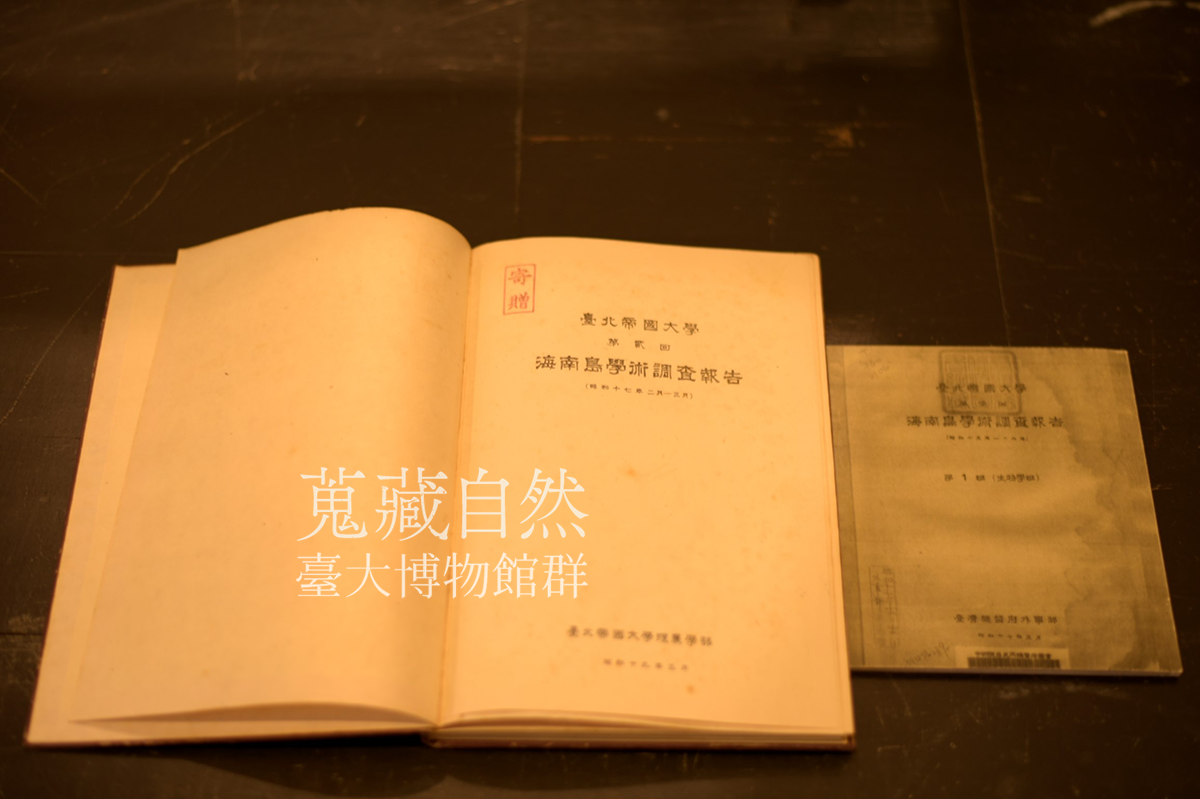
海南島調查成果報告一批
Report of the Hainan Island Survey
臺北帝大派往海南島的學術調查團各學科有許多豐厚成果,以及植物部分此次展出部分的成果包含海南島植物誌、海南島的防己科植物以及海南島崖縣大東海海岸植物相,由於海南島開發較早,目前植被幾乎破壞殆盡,臺大所典藏的海南島標本更顯珍貴。
Various groups sent to Hainan Island for academic survey by Taihoku Imperial University produced fruitful results. The exhibition this time includes the Flora of Hainan Island, the Menispermaceae of Hainan Island, and the coastal flora of the Dadonghai area, Yazhou District, Hainan Island. Due to the early development of Hainan Island, currently the vegetation has been almost completely destroyed, making the specimens in NTU’s collection even more precious.

日文報紙摺成三角袋,內有未展翅的標本
Japanese Newspaper Folded into Triangle Envelopes with Specimens Prior to Wing Setting
蝴蝶及蛾類在採集後,一般會使用蠟光紙摺成三角紙袋,進行簡單的收納及保存,日後可以再做成展翅標本。臺北帝大時期留存於臺大昆蟲標本館典藏室內的一批標本,當時的研究者直接用報紙摺成三角紙袋使用。
After butterflies and moths are collected, they are usually stored and preserved in triangle envelopes made with waxed paper. Later they will be turned into specimens with their wings set. There is a batch of specimens in the NTU Insect Museum from the Taihoku Imperial University period. Back at the time, researchers folded newspaper into triangle envelopes.


